Tags
1980's, 80's animation, a duo, american tail, an american tail, animated, animated feature, animated movie, animated movie review, animation, anthropomorphic animal, anthropomorphic animals, Barry Mann, bluth animation, cossacks, Cynthia Weil, Dom DeLuise, Don Bluth, dreams to dream, Ellis Island, fievel, fievel mousekewitz, Gary Goldman, giant mouse of minsk, give me your tired, immigrants, immigration, irish animation, James Horner, John Pomeroy, Madeleine Kahn, mice, mott street maulers, mouse, never say never, New York, no cats in america, obscure animated movie, obscure animation, Phiilip Glasser, somewhere out there, statue of liberty, steven spielburg, storm, street gang, sweatshop, tanya, tanya mousekewitz, tiger, tony and bridget

“Somewhere out there, beneath the pale moonlight
Someone’s thinking of me, and loving me tonight…”
Chances are if you were to name a well-known American animation auteur besides Walt Disney, most of us who were children in the 80’s and 90’s will point to one man: Don Bluth.

Bluth formed his studio in the hopes that he could make quality entertainment unlike what Disney was putting out; the irony is that not only did Bluth use to work for Disney up through the seventies, but his career almost mirrors much of Walt and his studio’s ups and downs. Their early films are considered their best despite the common criticism that they’re too dark for children, and over time they grew lighter and softer to the point where they were criticized for, ironically, not being dark enough. That, and they made a few princess fairytale movies in the 90’s with their fair share of Oscar-bait ballads.
There’s also one other factor in this comparison which I think is important. For years after the premiere of “Snow White and the Seven Dwarfs”, every animated movie Walt Disney produced was inevitably compared to it. There was a period where Walt himself began to loathe Snow White because she seemed to overshadow all his other accomplishments. I have to wonder if Don Bluth feels the same way about his first foray into feature-length animation, 1982’s “The Secret of NIMH”, which many consider to be his best work. Admittedly I’m in that boat too, yet I feel guilty for saying it because doing so feels as though I’m negating everything that followed. Case in point – this month’s review.
“An American Tail” is one of the first Don Bluth movies I can remember seeing, and if it weren’t for “The Secret of NIMH” it’d be my number one favorite Bluth film. But hey, it comes this close. Funny thing is, I didn’t watch it all that much when I was kid, and not entirely for the reasons you might think. Sure, this movie has everything that comes with an 80’s Don Bluth production – heavy doses of nightmare fuel and a somewhat bleak atmosphere offset by cartoony animation, lighthearted songs, recurring comic relief actors and a happy ending – but it was on another one of those tapes that had more than one feature crammed on to it. In this case, An American Tail came on right after Ferngully: The Last Rainforest. Four year-old me liked Ferngully just fine, but was never invested enough that she’d watch it all the way through to the end, usually stopping after the romantic “Dream Worth Keeping” segment because afterwards things got dark and moody and there weren’t any more songs. And if I did sit through it all, then I’d have to be in the right kind of mood to watch An American Tail because that was dark and moody and THOSE GDAMN CLOSE CALLS WHERE HE COULD HAVE FOUND HIS FAMILY IF HE ONLY –
…anyway, I’ve come to appreciate it much more for what it is an adult than as a kid for a number of reasons. That nostalgia is still there, but it’s well-tempered by time and a deeper understanding of the socio-economic background behind the making of this movie as well as the historical fictional one where the story is set.
Oh, did I mention I’m highly educated in happenings from the time period this all takes place in? Because I am. And this entire review is going to be part-silly observational jokes and part-gushing over how much history they cram into the tiniest details.
We open with some large CGI snowflakes falling over a tiny village in late 1880’s Russia with a score that reminds me just how much I really freaking miss James Horner.
Hidden away in a cottage lives a family of Jewish mice, the Mousekewitzes. It’s Chanukah and Mama and Papa Mousekewitz (Erica Yohn and Nehemiah Persoff) give their children Tanya and Fievel (Amy Green and Philip Glasser) some gifts – a babushka for Tanya and a somewhat oversized family heirloom cap for Fievel. Papa entertains the children with the legend of the Giant Mouse of Minsk, a rodent so enormous that it scared away every cat in the vicinity. He also tells stories of a magical land of freedom and opportunity called America, where the streets are paved with cheese and more importantly, there are no cats at all.
But all this talk of hopes and dreams comes to a swift halt as the village falls under attack from Cossacks, Russians paid to terrorize and threaten Jewish communities. And in keeping with theming, the Jewish mice are tormented by, you guessed it, Russian Cossack cats.
Wait, did I say cats? I meant GIANT FURRY DEMONS OF HUNGER AND DEATH!!



Okay, having them wear matching clothing and little mustaches does take the edge off a bit, but you get the gist.
Now before some of you start crying about how Don Bluth ripped off Art Spiegelman and his singular graphic novel Maus, I’d like to point out that the idea of portraying mice as the oppressed and cats as the oppressors is one as old as Aesop. It’s practically a cliche by this point, but why fight it? When done right as in here and Maus, it can be terrifyingly effective. Instead of just making all cats nazis in this movie however, they correspond to the major threat pervading each country which the immigrant mice are hoping to escape from. In Russia, they’re Cossacks. In Italy, they’re the Mafia. In Ireland, well, the Irish mouse from “There Are No Cats in America” says a calico killed his lover. In other words, an Irish person was murdered by a Black and Tan.
See, it’s funny because the Black and Tan was a British military unit specifically created to repress Irish rebellion and they committed numerous sickening war crimes and murdered innocent people during their time in service aaaand moving on.
In short, this may always be another “Lion King ripped off Kimba the White Lion” scenario that animation aficionados and artistic intellectuals love to get their knickers in a twist over and I doubt we’ll ever know if Bluth really was inspired by Spiegelman, but my real question is this:
In spite of several consecutive close calls with the hungry cats, Fievel emerges from the skirmish unharmed as do the other Mousekewitzes, and they watch their home burn down in one of the most beautifully animated violent pogrom aftermaths ever.

Just to rub salt in the wound, the Cossacks also ruined Tevye’s daughter’s wedding offscreen.
Papa casually reminds the family that America is conveniently feline-free and one fade out later they’re boarding a ship in Germany that will take them there. They don’t show how they got to Germany but I imagine it playing out like a combination of “Life is Beautiful” and the escape from Atlanta from “Gone With The Wind”. Fievel keeps stopping the procession every couple of seconds to ask his papa questions about everything he sees and watching this again after a number of years, yes, I can see why Fievel tends to get on some people’s nerves. Kids are curious and innocent and Fievel certainly embodies those qualities, but he really pushes it at times. At worst he comes off as idiotic, least of all when he intentionally wanders into danger as many times as he does throughout the story. I let it slide because of my partiality to him due to nostalgia and how I see those similar attributes to in my younger self, but I don’t completely blame you if you aren’t a fan of him.
After the mice have been at sea for an undisclosed amount of time, cooped up in crowded quarters with only hope to sustain them, we get our first song, “There Are No Cats in America”, or as I like to call it “Bipolar Disorder: The Musical”. The song swings back and forth from mice of various nationalities singing of their feline-induced tragedies back in their homelands and lamenting lost loved ones to joyously dancing around and celebrating that they’re nearly halfway to America like they were in another movie. It’s a good song, don’t get me wrong, but the switch between the wonderfully peppy chorus and the slower sadder verses is jarring.
A storm hits, and Fievel, who’s not content with either sitting around in boredom and seasickness or singing tonal-schizophrenic tunes about the American dream, goes exploring above deck under the pretense of retrieving his hat. But before Papa can save him, Fievel is washed on to the rigging, and both can only watch in terror as a tidal wave sweeps him out to sea. Say what you will about Fievel, but the storm sequence is amazingly well-done. The size of the lightning and waves is magnified through his terrified child eyes, becoming monsters before him, and Horner knows how to ramp up the helplessness and fear of the situation, making the instruments and choir sing like the restless sea. All in all, it’s another one of those good old-fashioned Bluth nightmare fuel sequences.
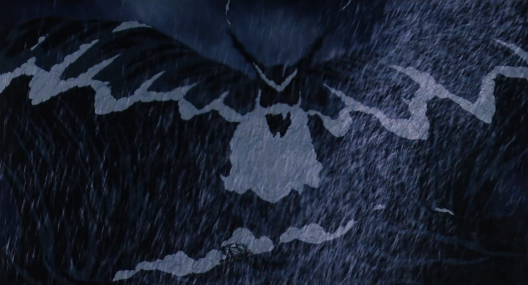
“Don’t mind us, just passing through to our Bald Mountain tailgate party.”
The ship weathers through the gale to Ellis Island. As the humans file through customs and begin their new lives as American citizens, so do their rodent counterparts. It’s a solemn affair considering the prior scene. Tanya gets her name changed to something less ethnic and more American sounding, as was the case for many immigrants, and is now legally known as Tilly (remember that now). Then there’s the look on Papa’s face when he has to stop himself from saying there’s five in the family and it breaks my heart every time.
Little do they know that Fievel has survived the storm and is about to be washed up on the shores of the soon-to-be-completed Statue of Liberty. And oh, that moment when he first lays eyes on it is something to behold. The sun breaking through the clouds, painting everything in gold, and a choir singing the famous “Give me your tired, your poor…” poem inscribed on the statue’s base…it’s just beautiful.
The first person Fievel meets is a French pigeon named Henri played by Christopher Plummer of all people. He welcomes the little mouse to America and shows Fievel the statue “he” is currently busy building which will welcome countless others like him. Fievel doubts he’ll ever find his family in such a big country, but Henri lifts his spirits with his tried and true motto “Never Say Never”.

Though come 2011 he’ll seriously consider changing it.
Funny how Christopher Plummer goes from playing a character forbidding music from his life to one fully embracing musical theatricality to make his point. And I totally forgot how earnest and uplifting this song is. I heard it again at a point in my work where I really needed to, and it got me in the right kind of mood to keep following my dreams. Henri has one of his chorus girls fly Fievel to immigration services where he’ll get all the help he need to reunite with his family.
On the mainland just outside of Ellis Island is a row of charlatans pawning off useless wares and taking advantage of new citizens; selling the Brooklyn bridge, fake tickets to out west, you get the idea. One such broker of hokum is the punnily-named Warren T. Rat, played by John Finnegan. He’s another fine actor who gives his all to what some at the time might have just phoned in as a generic kid’s movie villain. He auditioned by reciting Shakespeare as a Brooklyn cabbie, and someone must have been liked it enough that they worked in bits of Shakespeare into Warren’s dialogue, albeit misquoted for comedic effect.
Warren’s the leader of a protection racket between the mice and gangs of cats that roam the city streets and is always looking for more immigrants and business mice to swindle, a decent representation of those who preyed upon the naïveté of unsuspecting greenhorns fresh off the boat. Unfortunately they had to give Warren an aggravating little cockroach sidekick named Digit voiced by Will Ryan, who speaks in a high pitched voice like he’s constantly on a sugar rush, always gets in the way, is never funny and doesn’t know when to shut the hell up and OH DEAR GOD NO!
It’s Petrie.
It’s the same fucking character.
Someone up there must really have a twisted sense of humor to reincarnate the most annoying thing about The Land Before Time into a creature that can effectively never die. Then again maybe they wanted to spare heaven his constant inane chatter.
Fievel gets dropped off right outside Warren’s place and the con rat quickly convinces the kid that he knows where his family is. As messy as the animation can be throughout the film, one little touch I like is that Fievel adopts the walk cycle of whomever takes him under their wing at the moment, including Warren, like he’s so ready to cling on to any sort of semblance of family that he subconsciously makes it up himself as he moves.
Meanwhile, Mama and Papa Mousekewitz are still mourning Fievel. Tanya, however, has the nagging sensation that he’s still alive somewhere out there, beneath the pale moon light perhaps, but nothing can sway her parents. This all happens as Warren’s escorting Fievel to a sweatshop – which happens to be in the very same building the Mousekewitzes have made their new home in – where he sells the boy to the most obviously evil overseer outside of an Exodus retelling.

A word to the wise, future animators: unless your character has a detachable jaw or is Kirby, then their mouth shouldn’t be BIGGER THAN THEIR FREAKING HEAD.
At this point Fievel would have led the workers in song as they toiled away but it was cut. Call me crazy, but having a “Whistle While You Work” style musical number in a sweatshop where other poor immigrants roped into this hellhole toil away for slave labor sounds like an insensitive and all-around terrible idea. I hope the person who suggested this edit got a hefty raise and is living a cushy life somewhere in the Bahamas.
That night Fievel suggests to one of the workers, a teenager by the name of Tony Toponi (Pat Musick) that they make their escape while the slave drivers rest their whipping arms. Though initially skeptical, the jaded Tony goes along with it and makes up a bedsheet ladder with the help of the other mice. But Fievel scampers off in search of his family before Tony can thank him. Then we have a montage appropriately scored to Gilbert & Sullivan’s “Poor Wandering One” where Fievel braves the many, many perils of the big city alone and hungry as he continues his journey. He’s so desperate to find home that he assumes every violin he hears playing must be his father (doesn’t help that they’re always coincidentally playing his theme song). After one such encounter results in some trouble with a record player and a terrified housewife who throws everything in her wardrobe at him, Fievel runs into Tony again. Tony promises to help him and gives him the nickname “Filly” (remember that now).
And that’s where it starts.
You know what I’m talking about.
The one thing EVERYONE who’s seen this movie unanimously loathes to no end.
At several points throughout the film Fievel comes within inches, literally inches of being reunited with his family, only for some form of contrivance to pop up and cause them to just miss each other. It’s dramatic irony at its most intensely frustrating best, by which I mean its worst. If one of them bothered to look to their left or wait in one spot for just a couple of seconds then this movie would be over. And yes, I can almost understand why they would do this; for starters, well, see the previous statement. This movie would be twenty minutes long with zilch stakes. Second, you could say this is a way of showing one of the core themes of the picture, in that the invisible ties that bind us to those we love can bring us closer to them than we realize, both metaphorically and literally. But still…

FUCKING LOOK UP!!!
Tony leads Fievel into a marketplace but gets distracted when he lays eyes on an Irish suffragette named Bridget attempting to rally the other mice into doing something about the current cat situation. The mice try to shush her for even daring to say “cat”, which as we all know is the big c-word you can’t say in public and is a stand-in for “pussy”. Bridget proudly stands her ground, yet is reduced to repeating herself once she’s pulled into an impromptu meet cute with Tony.
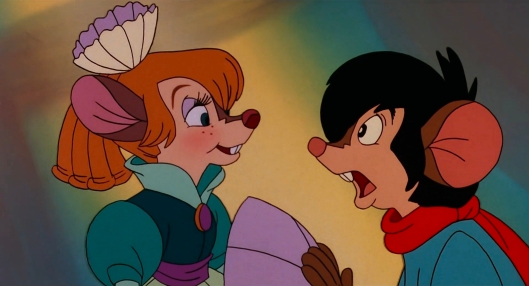

“She’s stuck in a loop and he’s an idiot. Well, that’s love for you.”
While I’m not crazy about love at first sight romances in animated films, there’s still something innocent and sweet about this one that I like. I think it’s because in other films they keep the lovers separated for too long for them and us to build a more meaningful connection (the early Disney princesses with their respective princes, Thumbelina and Cornelius) whereas after this moment Bridget and Tony are nearly always together doing something and don’t sacrifice whatever characteristics they have in order to serve as the other’s satellite love interest.
Sensing that this is getting awkward as well as some ominous foreboding, the other mice abandon the market. Fievel tries to convince them to stay and that there’s no cats in America like in the song, but is instantly proven horribly, horribly wrong.
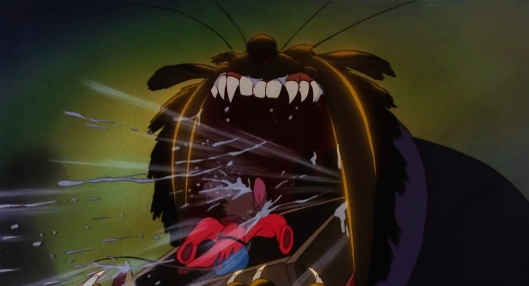
Is this movie’s mission to eat the viewer along with Fievel?
You know, between Dragon from The Secret of NIMH and this movie, I get the feeling Don Bluth wasn’t the biggest lover of felines.
Fievel exercises his power of main character and escapes death once more while the cats leave the market wrecked in their wake. Tony relays the boy’s situation to Bridget who suggests seeing a local politician by the name of Honest John at Tamany Hall for help. They take him there, once again missing the Mousekewitzes by THIS much.

Honest John, a corpulent and almost always drunken Irish politician, is in the middle of holding a wake at Tammany Hall for a victim of the ongoing cat attacks. Judging by the holes in the floor made by whatever spills from the glass he constantly holds, he apparently enjoys drinking acid. I knew those Tammany Hall fellas were made of hard stuff, but WOW. Also Honest John takes down the names of victims whose wakes he attends in order to garner fake votes in future elections using their names.

Ah, so that’s where Sideshow Bob got it from.
I love the inclusion of this entire scene. It’s not much, but when comparing it to the real deal, it’s a subtle illustration of one of the most openly and massively corrupted institutions in American history. Tammany Hall was to the 1800’s what the current political administration is today, except those back then took advantage of immigrants seeking help instead of violently telling them to GTFO. Everything about TH from its inception to “Boss” Tweed fascinated me when we reached that particular period in history and social studies, and how it was all brought down by Thomas Nast, a political cartoonist with an eye for caricature and wit as pointed as a newly sharpened pencil, permanently enamored me with the idea that art can make a statement and ignite change in the world.
The swinging wake is interrupted by the arrival of one Gussie Mausheimer, renowned philanthropist and the wealthiest mouse in the city played by none other than Madeleine Freaking Kahn! Damn, this movie really racks up some star power! Of course being Madeleine Freaking Kahn she brings her charm and quick comedic timing to Gussie as well as utilizing her Elmer Fudd style of speaking from Blazing Saddles, and she makes the most out of every scene she’s in (“Money is not evwything, I know because I have money and I have evwything”). Gussie’s had it up to here with with the frequent cat massacres; they’re not even discriminating between the rich and poor mice, those egalitarian savages! To that effect she’s come to organize a wawwy – er, rally for the following morning where mice from all walks of life are invited to attend.
That night before falling asleep, Fievel and Tanya overlook the city skyline from their respective hideyholes and sing the series’ flagship song “Somewhere Out There”. And yeah, there’s a reason why this is the one thing most people remember from this movie. It’s a classic that can hold its own against anything from the Disney songbook. I love the end credits version too, one could even say the trend of pop ballads closing out animated films began with this, but there’s something very special about the original. Philip Glasser and Betsy Cathcart’s vocals aren’t exactly polished, yet if they gave this song to professional singers it would lose that touch of verisimilitude. Having it sung by children who pour their passionate pitchy all into it makes it feel more genuine. You believe that these are two siblings reaching out to each other through their shared music, that the immeasurable distance cannot break their bond as long as they believe they can find each other.
Once again I have to hand it to James Horner for putting everything into what could have been disgustingly saccharine drivel in the wrong hands. But credit is where credit’s due, Barry Mann and Cynthia Weil really tie it together with their top-notch scoring and stirring lyrics. I’m surprised that these two don’t get as much attention as other songwriting teams considering their resume – this movie, Oliver and Company, Muppet Treasure Island, the theme songs to Balto, The Pagemaster and National Lampoon’s Christmas Vacation, and the majority of the music in the Carol King Broadway musical Beautiful, just to give you an idea. Suffice it to say this couple deserves more recognition than they already get.
At the rally Gussie and Honest John inspire the masses with talk of fweedom and putting an end to the cats’ reign of terror. Since they’re so desperate for ideas that they’ll literally take whatever’s thrown out there, guess who they decide to listen to?
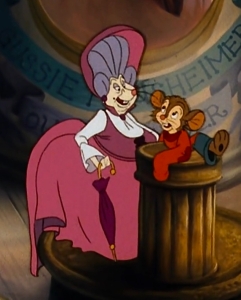
“Hey, have you thought about building a giant mouse monster that looked like it crawled from the bowels of hell and using that along with a bunch of pyrotechnics to scare the cats into leaving the country?” “How old are you, kid?” “Five.” “You’re hired!”
After dark, all the mice, including the Mousekewitzes, gather in an abandoned Mystery Shack prototype by the pier and begin building their secret weapon. But on the way there Fievel gets separated from Tony and hears some violin music coming from the sewer, so of course he has to follow it. There he finds some creepy crawlies, a pike/eel/fish thing in the water that I think was the inspiration for the wall eels in Banjo-Kazooie, and the hideout of the gang of cats that’s been terrorizing New York, the Mott Street Maulers. All well and good, but…

*sigh*
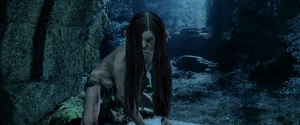
“What’s wrong, Shelf? The just missed ’em cliche finally getting to you?”

“I dunno, Cyn. We’re nearly an hour into this movie and I am enjoying it, but I feel like it’s missing something.”

“Missing something like a good car chase, or missing something like a more coherent plot?”

“No, more like missing a component that’s part of the norm. We’ve hit nearly all the Don Bluth trademarks so far but there’s one that seems like we’ve taken forever to get to. A bright spot ingrained in my infancy that speaks with -“

“Wait a minute…speaks…Can it be?”


“TIGER!!!!”

No joke, folks. I. Love. Tiger. After how downright bleak this movie can be, his sweetness and humor is sincerely welcome. A major part of that has to do with his voice actor. I have the softest of soft spots for Dom DeLuise having grown up hearing him in dozens of cartoons, and despite being typecast as the big warmhearted goofball he still gave every part his all. From what I’ve read he was very much like that in real life too and I especially see that in Tiger. He channels Bert Lahr’s Cowardly Lion to endearing effect. Itchy from All Dogs Go To Heaven is his best acted role and Jeremy from The Secret of NIMH gets the ball rolling in regards to plot and dramatic stakes, but Tiger will always be my number one favorite of his Bluth characters, though my inner child always gets excited to see and hear Dom in just about anything he’s in.

Jesus Christ, people, even I have my limits!!
Moving on, Warren’s the one who’s been butchering the violin, and secure in his privacy he removes his nose and ears to reveal a dark secret – he’s really a CAT all along! And a really tiny one too given how he’s only a few heads taller than Fievel.
Warren discovers the cat’s out of the bag and has his goons go after Fievel. After a harrowing chase through the sewers he emerges on the street safe and sound, but lingers just a smidge too long outside the manhole and gets dragged back in. He’s locked up in a cage yet as fate would have it Tiger is set to guard him. The two instantly bond over lost families. I’m also convinced this is where they let Dom have some fun with improv (“I lost my family too; eight brothers…ten sisters…three fathers…”) Tiger shyly reveals he’s a closet vegetarian, so there’s nothing to fear from him.
This is why I believe the inclusion of Tiger is an integral part of this movie. The cats are a suitable representation for everything carried from the old world to the new that the mice must overcome, but Tiger’s the necessary stroke of gray to be found hidden between the shades of black and white. His character symbolizes how people living within the same race or lifestyle that are viewed as “the bad guys” aren’t always as evil as the worst of their kind. There are those who hate the acts of violence or superiority that their own propagate yet feel powerless to stop it or are intimidated into going along with it. The scene where Tiger struggles to keep up appearances during his card game with the Mott Street Maulers is a notable example. Also note he was conspicuously absent during the attack on the marketplace (though the recycled animation from the pogrom might have had something to do with it also). Speaking as someone who was bullied for not disguising my differences well enough throughout my school years, to say I relate is an understatement. It really makes me wish we got to see more of Tiger, but that’s what we have Fievel Goes West for.
Tiger lets Fievel out of his cage and they affirm their new friendship in “A Duo”, my preferred choice of animated buddy songs (sorry “You’ve Got a Friend in Me”, you’re a great runner-up) and it narrowly beats “Somewhere Out There” as my favorite song from this film by virtue of Dom and how much I could squeeze Tiger into oblivion he’s such an adorable…well, you get the idea. That and again, coming from a person who had relatively few true friends in the past, that slow realization that I might have something in common with someone who starts out as a stranger and quickly evolves into something meaningful is encapsulated in those two and a half minutes. I can never feel down when listening to it; it’s instant joy in musical form.
No sooner does the song wrap up though than an alarm goes off alerting the other cats to Fievel’s release. Tiger lets Fievel escape and as Warren confronts him, he finally gathers the courage to up and leave the gang, telling Warren to his face he never liked him to begin with. He has a real friend now, so he doesn’t need the validation of a group he had to pretend to be a part of in order to get by.

So good news: Fievel’s free.
Bad news: He’s leading the cats to the pier earlier than the set plan and it throws everything out of whack.
Amidst the chaos the order to release the secret weapon is accidentally given and Honest John and the mice inside the mystery museum rush to stop it before it comes crashing through the gates. Outside Warren is back in his disguise and he delivers an ultimatum – give him Fievel and he’ll forget this whole thing happened or everyone dies. Fievel insists that Warren is a cat and Tony exposes him by knocking off his nose and ears with a slingshot, to which Warren replies with “C’mon, who ya gonna believe, me or your own eyes?”
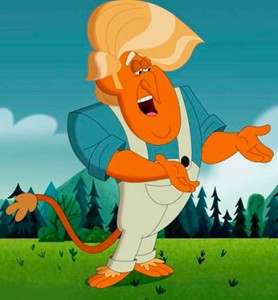
“Oohh, good one! Gotta use that at the next press conference.”
Since he can’t talk his way out of this one, an infuriated Warren sets fire to the museum. What’s worse, the ace in the hole is tied down at last, but the signal for its release, a steam ship whistle for a boat heading out to Hong Kong, goes off. Gussie still goes ahead and gives the official command to wewease the secwet weapon.

“Also, wewease Wodger! And wewease Wodewick! And Weuben, Weginald, and Bwian!”
With the clock quickly winding down, Fievel uses the flames to his advantage by burning through the ropes holding back the weapon before he gets knocked out.
And what is this secret weapon that this whole movie has been building up to, you may ask?
Well, it’s quite simple.
It is the stuff of 80’s-90’s kid nightmares.

The mice have built a massive mechanical Giant Mouse of Minsk. And it is both horror incarnate and pure awesome, like the world’s biggest, scariest parade float. Not to mention there’s the added brilliance of the subtext of its role in the story, and it is this:
The Giant Mouse of Minsk is a golem.

No, that’s a Gollum.

THIS is a golem.
Golem are legendary monsters from Jewish folklore, inanimate creatures given life by those well-versed in the most arcane of Jewish mysticism in order to serve them and play God; a proto-Frankenstein’s monster, if you will. The most famous story about golem is The Golem of Prague, which was created by a rabbi to defend a Jewish ghetto from anti-Semetic attacks. The Mouse of Minsk fulfills the same purpose. It’s a giant monster made to scare away evil-doers looking to harm a group of marginalized people, with the bonus that it was created by someone of Jewish origin. Plus it shoots fireworks from its mouth. Nice.
The petrified cats are sent hurtling off the pier and on to the ship in the nick of time. The mice send them off with a reprise of “There Are No Cats in America” and Warren assures his cohorts that there’s plenty of mice to be had in Hong Kong, blissfully unaware of what makes up the secret ingredient of their chow mein.

Here’s a hint: their pet shelters are never full for very long.
Yet there’s little time to revel as the fire Warren started rapidly spreads to the rest of the pier. As the Mousekewitzes escape, they run into Tony and Bridget searching for “Filly”. Tanya makes the connection to Fievel thanks to her own similar name change at Ellis Island and pesters her father into asking if they know her brother. Papa’s reluctant to believe they’re talking about the same Fievel until Tony shows them his cap.
Unfortunately while this is going on an unconscious Fievel is washed down the sewers by the fire brigade and finds himself in an alley where dozens of orphaned young mice have taken refuge. Three particularly cynical boys mock his devotion to his family and finally break his spirits with one horribly blunt armor-piecing question – if his family loves him so much, why aren’t they out looking for him? From the start Fievel has been nothing but hopefully optimistic, and to see him finally give into crushing despair after so long is nothing short of heartwrenching. And don’t get me started on James Horner’s score again, just don’t. I’m still getting over it. Even if I do remember it more for its use in Fievel Goes West as the melody for “Dreams to Dream”.
The grey rain of melancholy gives way to a misty sunrise as Tanya, Mama and Papa, Bridget, Tony, Gussie and Tiger search the city streets for Fievel. And this is what I don’t get when someone says this movie is full of useless side characters. Fievel changes the lives of everyone he meets for the better and inspires them to become better people. Tony was cynical and had no guidance, believing he was stuck in that sweatshop forever, but after Fievel freed him he slowly shed his tough guy persona and became more open to caring about others. Bridget regains hope for better days to come as well as an audience and someone who loves and listens to her. Honest John goes from making empty promises and abusing his power to actually doing something to ensure a positive future and putting himself in harm’s way for his constituents. Tiger, well, I don’t think I need to elaborate on him any further. And Gussie, while already having an established reputation as a philanthropist, kept a sizable distance between herself and the lower classes (On entering the wake she cries out “There’s a dead mouse on this table!” and speaks with a palpable air of superiority to those around her) but over the course of the story loses that snooty attitude and gets down and dirty with the rest of them in order to defend their equal god-given fweedoms. She even overcomes her prejudice of cats to aid the search party. And in the end, everyone Fievel helps comes together to help him. It’s wonderful karmic and cinematic payoff.
Fievel awakens as he hears his sister’s voice and his father’s music in the distance. Quietly he mouths “Papa?”, daring to hope once more. And even when Papa and Fievel are running towards each other’s arms they still miss just to make it all the more beautiful and satisfying when they finally do reach each other and everyone’s sobbing and laughing and and OH MY HEART WHY DO YOU KEEP DOING THIS TO ME BLUTH!!
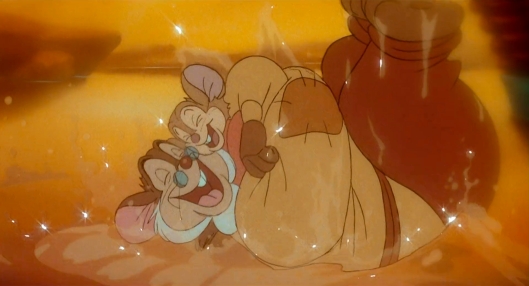

Yes. All these years later it still makes me cry. And I’m not embarrassed to say it.
Reunited at long, long last, Papa returns Fievel’s hat and this time it fits, reflecting how much he’s grown from his adventure. From there we cut to Henri and the pigeons taking the Mousekewitzes – and Tiger too – on a fly-by of the recently unveiled Statue of Liberty which inexplicably winks at Fievel and Tanya as they pass.
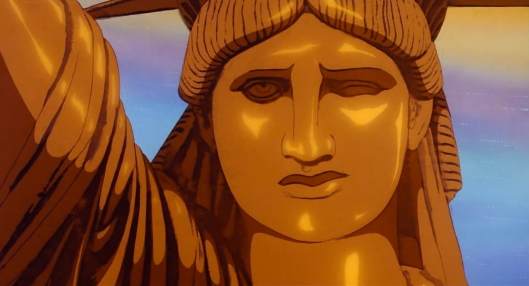
“Hey there, kids. Just killing time until Viggo the Carpathian attacks.”
Fievel spies more land on the horizon, more America to explore. He asks Henri if he’ll get to see it and Henri states he will someday.

Oh, you have no idea, Fievel.
An American Tail, while obscure in the eyes of today’s modern animation boom, has developed a a semi-cult following by those who saw it as children. And I’d say it’s justly earned. It doesn’t pull any punches and isn’t afraid to get dark and scary, largely due to Don Bluth’s treasured belief that children can sit through anything as long as there’s a happy ending. I actually have to agree with him on that. It was a big hit upon arrival, even beating Disney’s The Great Mouse Detective, another animated film about little mice having adventures in a very big world released that very same year. Then again, having STEVEN SPIELBERG as your producer and main pull at Universal does give you a bit of a boost. His own family history inspired the story somewhat – not just the usual son trying to reconnect with his father/shooting star/adventure seen from a child’s POV motifs that pepper his most notable works, I mean. Spielberg’s own grandfather was a Jewish immigrant from Eastern Europe. The scene where Fievel presses against a schoolhouse window and watches the students reciting the Pledge of Allegiance was directly lifted from his childhood. And his name just happened to be Fievel. Don Bluth wasn’t sure audiences would gravitate towards a character with such a unique name, so the “Filly” nickname was introduced as a compromise. I think it’s safe to say Bluth’s fears were unfounded. The very name is associated with the franchise as much as “Somewhere Out There” is.
Even if the animation is sketchy at times (pun not intended) and of an lower overall quality from that of The Secret of NIMH, when they get it right they get it absolutely right. I especially appreciate how all the humans and certain objects like the Mouse of Minsk were rotoscoped (filmed in live action then traced over frame by frame) which not only adds a touch of realism that shows just how different the bigger world and the world of the cartoony mice are but also makes the whole movie look even more like a living illustration from that time period. As if I can’t go on about it enough the history that’s put on display is part of what draws me back time after time. And Horner’s score, which is easily among my favorites ever created.
If you’re not a fan of An American Tail, I get where you’re coming from. Don Bluth is something of an acquired taste even if you’re an animation fanatic. Some of my good friends complain that An American Tail in particular is too emotionally manipulative to enjoy. I hate to burst their bubble but ALL media is manipulative in some kind of way, using various methods to make you react and feel different things as you stare at a rectangle or flip through leather-bound compressed pulp with ink printed on it. I suppose the word they’re looking for is “forced”, but damn if that force isn’t effective. Its imperfect parts come together to form an emotional cathartic whole. Easily one of the best film screenings I’ve ever been to was when they showed this at Brooklyn Bridge Park the summer of 2011. A perfect view of the Manhattan skyline provided the best possible backdrop, the audience was happily invested and showed it at the reunion scene, and it ended with a surprise fireworks show.
An American Tail is one of those movies I don’t watch very often because, like I said at the start of this review, I have to be in the right kind of mood to get sucked into the drama and sentiment. But when I do, I’m reminded of why I love it as much as I do, imperfections and all. All else aside, one of the reasons why I feel such a kinship to it is because my own great-great grandparents came to America through Ellis Island like countless others. They dared to start a new life in a new country that promised freedoms the old world failed to give them. And even though the song was a lie and there were cats in America of all shapes and sizes, those immigrants were not daunted by them. Because given the freedoms of speech and to band together to do something, given the chance to work through prejudices and move up with a louder greater voice, those cats can be conquered, even today.
Thank you for reading. If you like what you see and want more reviews, vote for what movie you want me to look at next by leaving it in the comments or emailing me at upontheshelfshow@gmail.com. Remember, you can only vote once a month. The list of movies available to vote for are under “What’s On the Shelf”.
If you want to support me and see whether the Giant Mouse of Minsk or Grunkle Stan’s “I EAT KIDS” balloon would win in a fight to the death, please consider supporting my Patreon. It’s completely optional, you can back out any time you choose, and it comes with perks like extra votes and adding movies of your choice for future reviews. Special thanks to Amelia Jones and Gordhan Ranaj for their contributions, AND for donating to this month’s Charity Vote Bonuses. I’d also like to thank Abigail Kane for her $20 charity donation as well. In keeping with the bonuses promised, John Carpenter’s brilliant and bonechilling 1982 remake of The Thing has been added to The Shelf, and you can expect your requested review of Disney’s Pinocchio in a few months!
Lastly, thank you all for being so patient with how late this review was. Luckily I was able to get my computer troubles all sorted out and nothing’s stopping me from getting back on schedule. I’ll see you on the first of September when we’ll be looking at one of the all-time great American musicals!
Artwork by Charles Moss.



AAAAAAAAAAAAAAAAAAAAAAAAAAAAAAAAAAAA-
*ahem* Excellent review, Shelf. Here’s a personal story; a few months ago, I was asked by a family friend to babysit her daughter for a few hours. We ended up watching this very movie on Netflix, and we both enjoyed it very much.
Perhaps next donation, I’ll request Secret of Nimh. That, or Ernest and Celestine. (If you haven’t seen the latter, DO IT. It has Forest Whitaker and Lauren Bacall in the fantastic English dub.)
LikeLiked by 1 person
Aww, glad you both had a good time =)
LikeLike
Love the review with the Fiddler on the Roof reference, the Justin Bieber song reference (which I also thought of when I saw the film), and I broke out laughing at “Wewease Wodger and Wodewick”, lol!
I didn’t grow up with Don Bluth films and when I was younger, I considered him a Disney traitor, hence there is no Don Bluth film that I “like”. So I didn’t really “like” this film either, but the historical parallels were great though.
LikeLiked by 1 person
Fair enough, I suppose. If the comments on the Waking Sleeping Beauty documentary are anything to go by, that sentiment is still felt by plenty. Something I failed to mention in the review and hope I get to discuss more the next time I review a Don Bluth movie is that Don’s departure and formation of his studio was kind of the kick in the pants Disney needed to get their animated movies back to the quality they were known for. In a way the early Bluth films helped pave the way for the 90’s Renaissance.
Glad you loved the review!
LikeLiked by 1 person
Oh yes, people have mentioned to me that Bluth leaving was the “necessary evil” that Disney needed to get the Renaissance going. And I can agree with that. I just still considered Bluth a traitor when younger; I’ve mellowed my opinion on him as I got older.
LikeLiked by 1 person
Wow, An American Tail is more relevant than I thought it would be.
Also, props for letting us learn more of the historical context of the setting.
LikeLiked by 1 person
Thanks! Yes, it is surprisingly relevant today. And if you took away something from my unsubtle history lesson, I’m glad. =)
LikeLiked by 1 person
Pingback: January Review: Pinocchio (1940) | Up On The Shelf
Pingback: My Top 21 Favorite Donald Duck Shorts | Up On The Shelf
Pingback: Happy 2020! / Blog Plans for the Year / Poorly Explained Movie Plots | Up On The Shelf